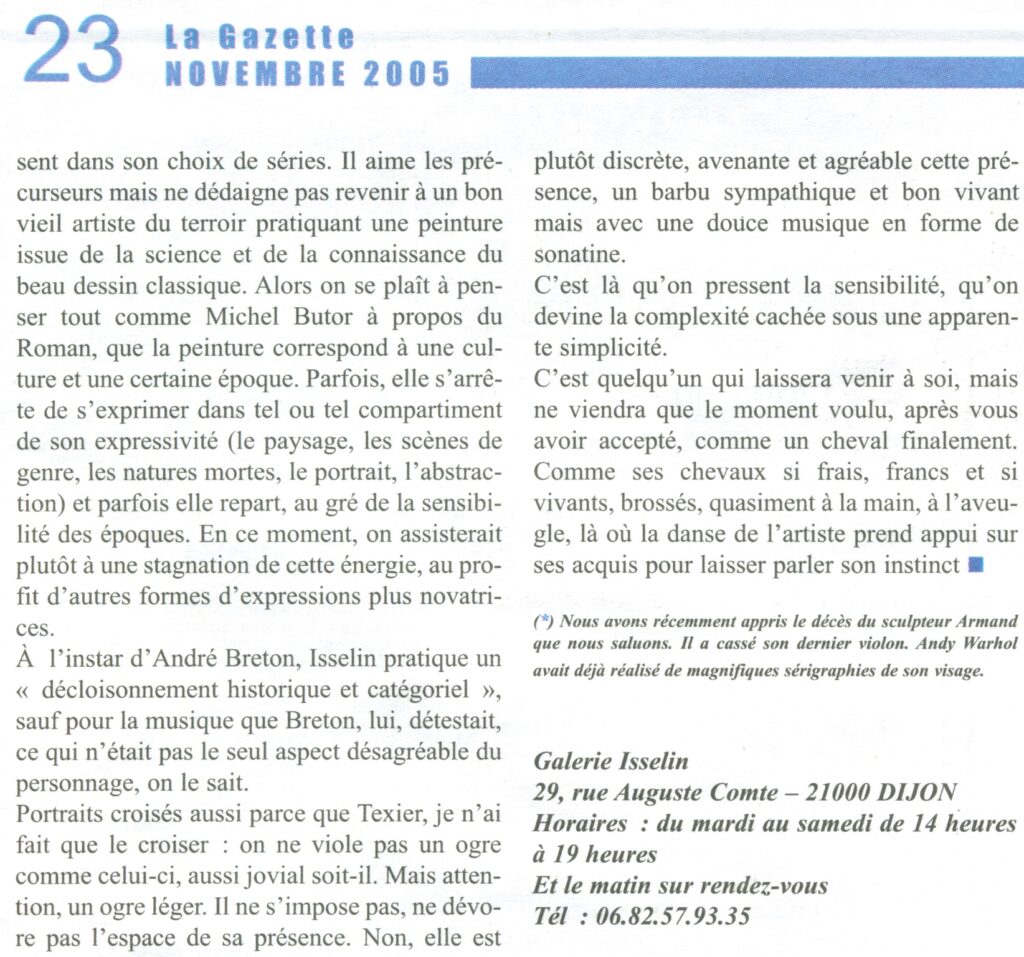Article – La Gazette newspaper – November 2015


Olivier Felix Isselin – Archives.
Jean-Yves Texier at Isselin Gallery.
A being radiates based on the awareness of their potential pleasure and the power they have to navigate that pleasure, coupled, of course, with their zest for life, as long as no grain of sand disrupts this jubilation of living.
So, can one engage in a field of activity and pursue poetry, art criticism, film criticism, or literary criticism at the same time?
Certainly, yes. The key is to be able to bring together these different forms of writing and to reach their essence within oneself. And there, as the English would say, “it’s an other pair of sleeves.”
Olivier Isselin exhibits about twenty paintings by Jean-Yves Texier in his new space. This young gallery owner was born in the Langres region, just like Texier. They have always been acquainted, and one could say that Isselin was incarnated there to one day have the opportunity to exhibit his elder, Texier.
So, Isselin, a young talent discoverer with a background in architecture and scenography, loves cultural moments and would like to open the eyes of the people of Dijon to contemporary art. His perspective on art is simply to derive pleasure from it. His idea: to support those he believes in, to defend a team, regardless of the diversity of their modes of expression. Yes, because initially, based on the early exhibitions in these spaces, one might have feared a consistently focused orientation towards photography and its derivatives, retouched and painted photos, etc… (John Batho is among the artists favored by the gallery). However, there is an observed eclecticism combined with a desire to remain intimate, within a bouquet befitting his sensibility. Olivier sniffs around, searches, sorts, and finds, based on his elective affinities, members of his “team.” He values his independence and works on project commissions rather than riding the wave of trends. He travels extensively, attends contemporary art fairs and exhibitions like Basel, F.I.A.C., etc., in order to have a keen sense and maintain the necessary culture for the risky profession he has chosen to embrace. On a personal level, he is more involved in the production and defense of engaged artists. Texier perfectly embodies the image described by his gallery owner when he says that one can be narrative in the sense of a dimension of narrative poetry, without falling into decoration or the decorative. Painting can be modern, contemporary, abstract, violent, gentle, figurative, etc., but it certainly should not be vain. That is not the case with Texier: he practices a series of busts or portraits (which is new because we have been following his work for about fifteen years), as well as the continuation of his animal series focused on horses and bulls. Well, Texier is primarily a draftsman endowed with remarkable virtuosity and a fairly distinctive drawing style. One can sense the speed, the passion. The brushes in his hands act as capes with which he makes passes in front of bull-canvas. There is a touch of Bacon in some of the small busts, a hint of Soutine in the portraits, sometimes mixed with an impression of Toulouse-Lautrec, but a Lautrec that has been shaken and blurred. That, in itself, is very interesting, even though one can sense that Texier is experiencing a slight dilemma, whether to delve further into shock and deconstruction, in short, become more “edgy,” or try to perfectly balance between the two tendencies: the classicism of his hand and the epilepsy of the line. Speaking of horses and bulls, the latter appear on the canvas as elements of picaresque frescoes that have been isolated from a larger ensemble or group, as they seem to respond to each other from one work to another. These are sketched paintings, where one can feel the dream of the brush carried by a ghostly hand that has lightly touched the surface of the water – pardon – the canvas, in a brief and almost hypothetical manner; did the painter really paint, or did he merely dream that he gracefully sketched a fleeting movement, so powerful that the imprint of this virtuality would etch itself?
The contrast is amusing with this free electron of a gallery owner in perpetual agitation, this mischief-maker enamored with electronic music; one passion is necessary to fuel another. He definitively calls himself “Warholian,” and it shows in his series choices. He loves pioneers but does not disdain returning to a good old local artist practicing a painting born out of science and knowledge of beautiful classical drawing. So, we are inclined to think, just like Michel Butor said about the novel, that painting corresponds to a culture and a certain era. Sometimes it stops expressing itself in one or another compartment of its expressiveness (landscape, genre scenes, still life, portraiture, abstraction), and sometimes it resumes, depending on the sensitivity of the times. At the moment, we are witnessing a stagnation of this energy, in favor of other more innovative forms of expression.
Following André Breton’s example, Isselin practices “historical and categorical decloisonnement,” except that, unlike Breton, he despises music, which was not the only disagreeable aspect of the man, as we know.
Crossed portraits also because Texier, I have only crossed paths with him: one does not violate such an ogre, as genial as he may be. But beware, a gentle ogre. He does not impose himself, does not devour the space with his presence. No, it is rather discreet, affable, and pleasant, a likable and lively bearded man but with a gentle sonatina-like music.
That’s where one senses the sensitivity, where one glimpses the complexity hidden beneath apparent simplicity.
He is someone who lets things come to him but only arrives when the moment is right, after accepting you, like a horse eventually would. Just like the horses, so fresh, spirited, and alive, brushed almost by hand, blindly, where the artist’s dance relies on his acquired skills to let his instinct speak.





